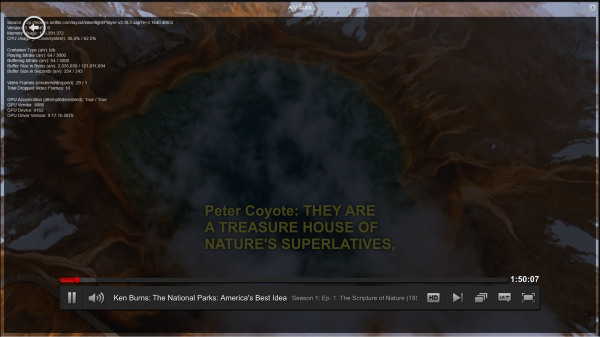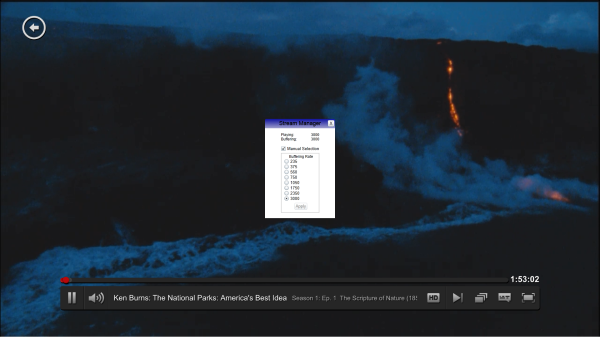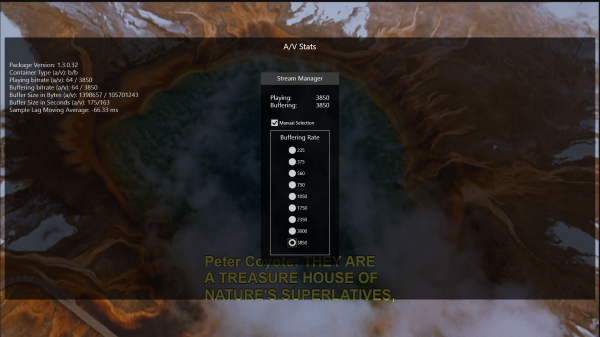Getting the Best out of an Ivy Bridge HTPC: Windows 8, madVR and More..
by Ganesh T S on January 20, 2013 3:00 PM EST- Posted in
- Home Theater
- Intel
- HTPC
- Ivy Bridge
- Windows 8
- Passive Cooling
Network Streaming Performance - Netflix
The drivers for the Intel HD 4000 enable hardware accelerated decode and rendering for Netflix streams in Silverlight on Windows 7. The Windows 8 Netflix app has been a bit of a mystery where it is not readily evident as to whether hardware acceleration is present or not, and whether it is being really utilized. In this section, we will take a look at how Netflix behaves on Windows 7 and Windows 8. The ISP at my location is Comcast, and unfortunately, there is no access to the Netflix 5 Mbps Super HD streams yet.
Netflix on Windows 7
On Windows 7, Netflix needs the Silverlight plug-in to be installed. We played back our standard test stream using Internet Explorer.
The Silverlight plug-in attempts GPU acceleration and enables it on our system. Manual stream selection is available. The maximum playback quality has a bitrate of 64 kbps for the audio and 3 Mbps for the video.
We will take a look at the efficiency of the system while playing back the stream towards the end of this section.
Netflix on Windows 8
On Windows 8, Netflix is streamed through a Metro app. Fortunately, the same debug shortcut keys used in the Silverlight version work here too. A nice add-on touch is that the manual stream selection and playback statistics OSD can be made to appear simultaneously.
It is not immediately evident as to whether hardware acceleration is being utilized or not. However, the aspect which stands out immediately is the fact that the video playback bitrate can go as high as 3.85 Mbps. Audio still remains at a lowly 64 kbps. Hopefully, a future update to the Netflix app can provide us with the soundtracks available on specialized media streamers.
Netflix Power Consumption - Windows 7 vs Windows 8
While the Silverlight plug-in OSD helpfully reports that GPU acceleration is being taken advantage of, it doesn't indicate the efficiency in any way. On the other hand, the Windows 8 app doesn't report GPU acceleration status at all. To determine the actual efficiency of Netflix playback, we recorded power consumption at the wall for both scenarios over a 10 minute interval during the middle of the stream.

The graph presents some very interesting results. With Windows 8, the system consumes much less power and the stream is also of higher quality. GPU acceleration in the app makes the streaming more than 30% efficient when compared to the Silverlight version. Compared to Windows 7 Silverlight, the Netflix app is efficient by approximately 35%. Windows 8, by itself, seems to consume less power too. Considering these results, if Netflix forms any part of your HTPC usage scenario, it is a no-brainer to upgrade from Windows 7 to Windows 8.













138 Comments
View All Comments
Hardcore69 - Sunday, January 20, 2013 - link
A lot of that GPU accelerated DirectX 11.1 stuff is used way more in the Modern UI than the deskto. And where were the power figures for the desktop version of the apps?ganeshts - Sunday, January 20, 2013 - link
Which apps are you talking about in particular?The Netflix app is the only 'Metro-specific' app that we installed. For comparison, we have power figures for Silverlight and Windows 8 too (if that is what you mean by desktop version of the Netflix app).
Everything else was the desktop version.
mavere - Sunday, January 20, 2013 - link
Is it possible to analyze where the Windows 8 power savings are coming from? In a couple tests, the benefits were equal to the entire TDP of some systems, and you'd think Microsoft would have advertised that aspect of Win8 more.I think I speak for most enthusiasts here when I say that the why and how is often more interesting than the what. :D
ganeshts - Tuesday, January 22, 2013 - link
I think a lot of that has to do with avoiding CPU loading (Silverlight), fully functional GPU accelerated decoding (again, not through Slverlight) and possibly DRM is handled through specialized CPU instructions instead of as a Silverlight component.The power differences seem to be non-existent in older systems as per other commenters, but, on modern CPUs / GPUs, it is very evident. So, I suspect a lot has to do with the updates made in the CPUs and GPUs in the last couple of years
Midgetsaw - Sunday, January 20, 2013 - link
This all very well and good but for me a htpc isn't any good without a tv tuner and windows 8 doesnt actually have media center. you have to contact ms to acquire it which is bs, all you have built is a glorified yt player, which you could have probably done with linux.lotharamious - Sunday, January 20, 2013 - link
Do you have Windows 8 Pro? I'd bet you do.Free upgrade from Windows 8 Pro to Windows 8 Pro with Media Center until January 31.
Go here:
http://windows.microsoft.com/en-US/windows-8/featu...
Give them a valid email address and enter the key they give you. Done. Windows 8 with Media Center.
So difficult to "contact ms", my ass. You just want an excuse to hate. I understand, many are like you.
Cygni - Monday, January 21, 2013 - link
Ah yes, finally I can pay to upgrade my OS to a less usable HTPC version, then either jump through hoops (if its the next week and a half )or PAY EXTRA to restore completely un-upgraded functionality that came free with the version I upgraded from.Oh thank you Microsoft, you're truly a gleaming light.
euler007 - Monday, January 21, 2013 - link
I guess free isn't good enough for you. Should they e-mail you a check to earn your anonumous forum support?Golgatha - Monday, January 21, 2013 - link
My time spent "upgrading" isn't free. Nor do I wish to experiment with Windows 8 further after already being maddened by it's ridiculous (for the desktop anyway) UI. I did try it for a few days and then I imaged back to my Win7 install. I like it better and all my programs work with it without issue.lexluthermiester - Monday, January 21, 2013 - link
There are a great many of us who feel your pain. I gave The Consumer Preview a shot and I kinda warmed up to it. The Release Preview ruined that warmth. And and fairness, I gave the retail release a solid month before washing my hands of it. I work for one of the few remaining brick and mortar tech shops in my area and we had a meeting with the owners a couple weeks ago. We were all prepared to tell them that we were unwilling to sell or support Windows 8 any further. To our joy they gave us those very instructions. You should have seen the smiles spreading around the room. And we are not the only ones snubbing 8. Three other shops in this area are doing the same. It was left to me to inform the MS reps of the news. Funny thing, when I did they weren't at all surprised. They didn't argue or try to talk us out of it. They simply said they'd be happy to continue supplying us with 7. I asked one of them why they didn't put up more of an objection. He answer said it all; "You're not the only company to take this position. We know that 8 is not well received or liked". When Microsoft's own reps are talking like that you just KNOW something's wrong. I think I'll leave it at that.